- Joined
- Aug 10, 2018
- Messages
- 2,070
- Reaction score
- 6,894
Day 4
My daily routine appeared to be: wake up, debate a layover day and then decide to move “a little”. Then, several hours later (like 8 or 10), decide that the next open campsite will do just fine and that tomorrow will, almost certainly, be a layover day.
I soon discovered that the camera didn’t survive the previous day. While not hermetically sealed in a dry bag, I had tried to make sure it stayed dry but either I was not diligent enough or it was too flimsy to be suitable for my purposes so I removed the batteries and sealed it in a spare dry bag. I would try it a few more times during the trip but, as I write this, it is on its way to a service center to see if it was water intrusion that killed it or if there is something defective in the camera itself.
After the light rain stopped mid-morning, the day was absolutely beautiful and the only people I saw were a pair that I had seen on the way into Frost lake. They said that they had spent an extra day fishing there and had done pretty well. One of them (or perhaps it was a group from the previous day) lost a naglene bottle on a portage and I picked it up. Before the trip was over, I would eventually add half of a broken ugly stick fishing rod, a couple of rusted lighters and an entire stuff sack full of garbage (that some lazy… let’s say “idiot”...) didn’t feel like carrying to my pack while only losing a lighter of my own in the process.
The bottle was a boon for fish suppers as it solved the problem of how to easily transport the filets. I carried it empty until I caught fish and, once cleaned, the filets were stuffed through the large opening of the bottle and the bottle was filled with fresh lake water. I would change the water periodically if it was a while before camping then simply rinse the bottle after supper.
The Frost river was a slow meandering body of water that was often only as wide as 20-25 feet and wouldn't be deep enough to paddle if not for the proliferation of beaver dams. It was reminiscent of the lazy river at any water based amusement park I’d ever been to except that the scenery was far more beautiful and other people were non-existent.
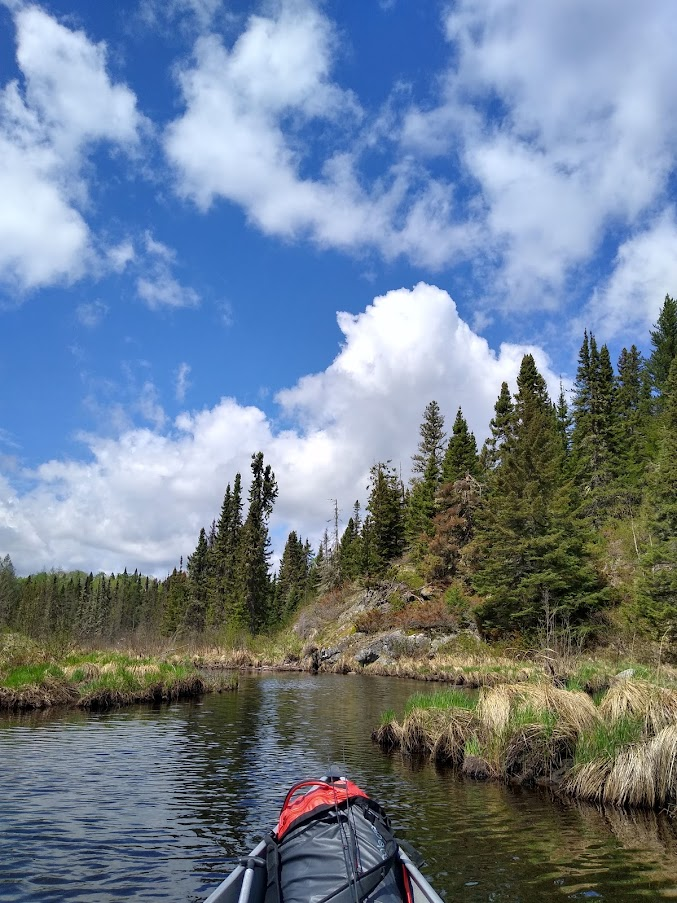
There were fewer portages than beaver dams on this day and it seemed that the preferred method of navigating a dam was to get up a decent head of steam and plow right over it. Almost all of the dams were fairly small and the drop in elevation was rarely more than a foot or two. I can only remember one place that was high enough to dissuade me from sliding over and, in that case, I stood on the dam and lifted the canoe over instead of portaging around.
While I suspect that the beavers may not view sliding over the dams in the same manner that I do, I can certainly say that it was a fun afternoon to paddle, ram & slide my way down such a gorgeous and pristine area of the forest.
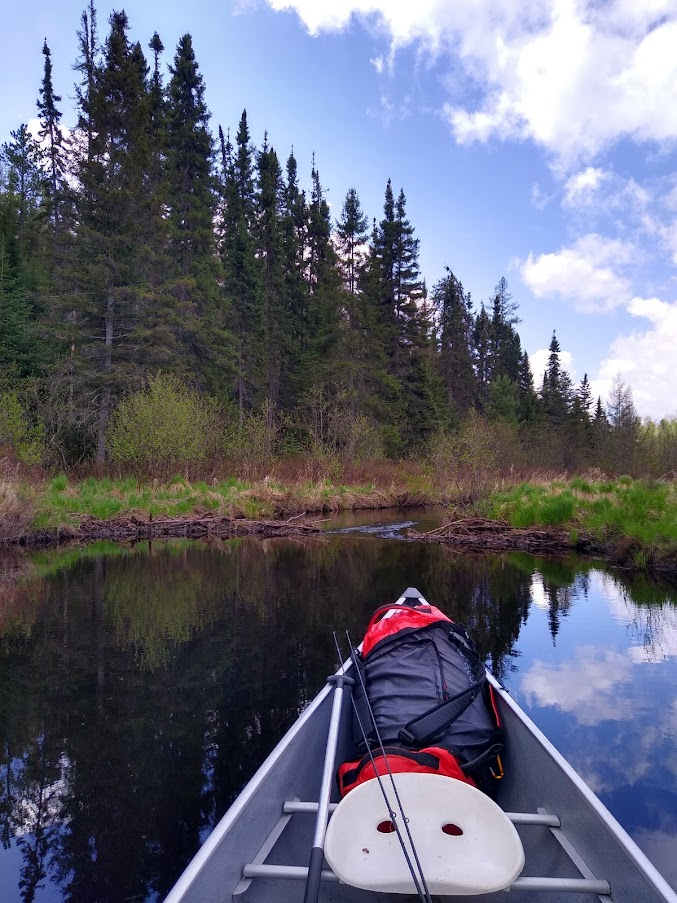
In fact, it was so pretty that I had a hard time selecting photos for this report and I’ll include an extra here if you’ll pardon the interruption of the narrative
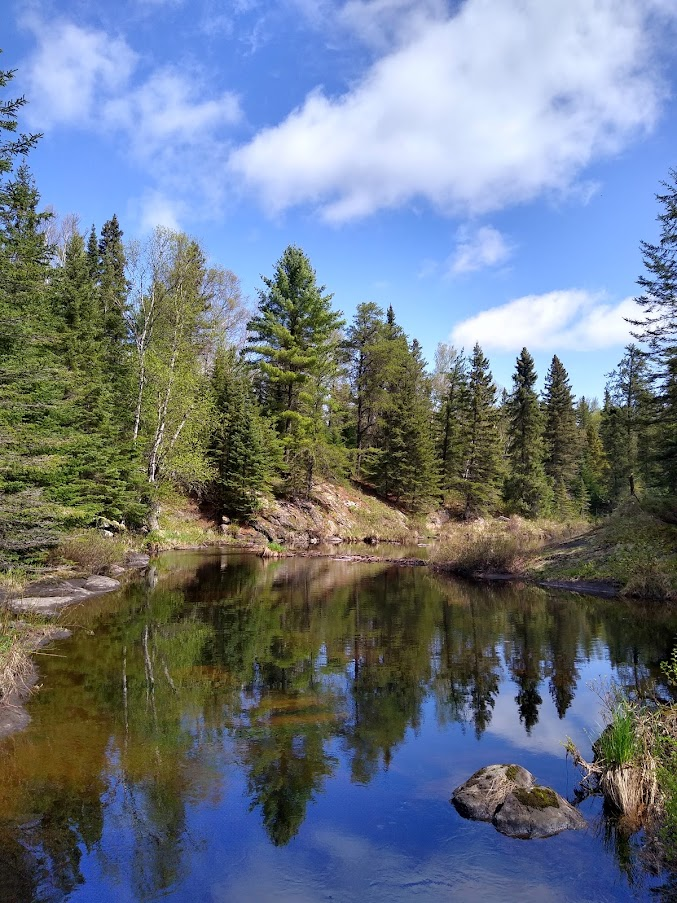
I checked out the campsite (#2226 on PP) at Whipped lake on the way past and it appears to be open (has a fire grate and thunderbox… what more could someone want, right?) but the large widow makers that were overhanging every nice tent pad would have me sleeping in the canoe.

Shortly after leaving that campsite I learned that short portages did not always mean easy portages… Honestly, the carry from Afton to Fente, although listed as only 25 rods, was probably the most difficult portage of the trip. It started out going up an extremely steep, 2 part, climb that I would guess to be 50 or 60 feet up (total) and then an even more treacherous descent which, I would think, would be nearly impossible if it were raining and the rocks were slippery. (I read later that it is sometimes possible to line through the rapids but this didn’t occur to me at the time)
I will say that there was a lot of paint on the rocks where people had either dropped canoes or simply slid them down the grade. I, trying to keep as much paint on the canoe as possible, was extremely careful on this portage and still managed to fall on my butt about ½ way down. With the canoe landing on top of me, however, no light blue paint was added to this particular location.

Up. (destination is the opening just above the top right corner of the large rock)

And over. (pictures just do not do this one justice)
The remainder of the day was uneventful but remarkably beautiful. The portage out of Afton, however, had taken a toll and I was thankful for the first open site on Mora. (#527 on PP and a huge site that would be great for a larger group). I hung out a clothesline, rinsed the clothes I was wearing and hung them in hopes that I might have dry clothes in the morning.
I think it was around this point that I scrapped the idea of bailing early on my planned route although I did study the maps closely that night to see if I could minimize the lengths of the portages.
The weather was perfect that night and I couldn’t ask for more. The “I’m OK” message went out at 8:15 and I was out not long afterward.
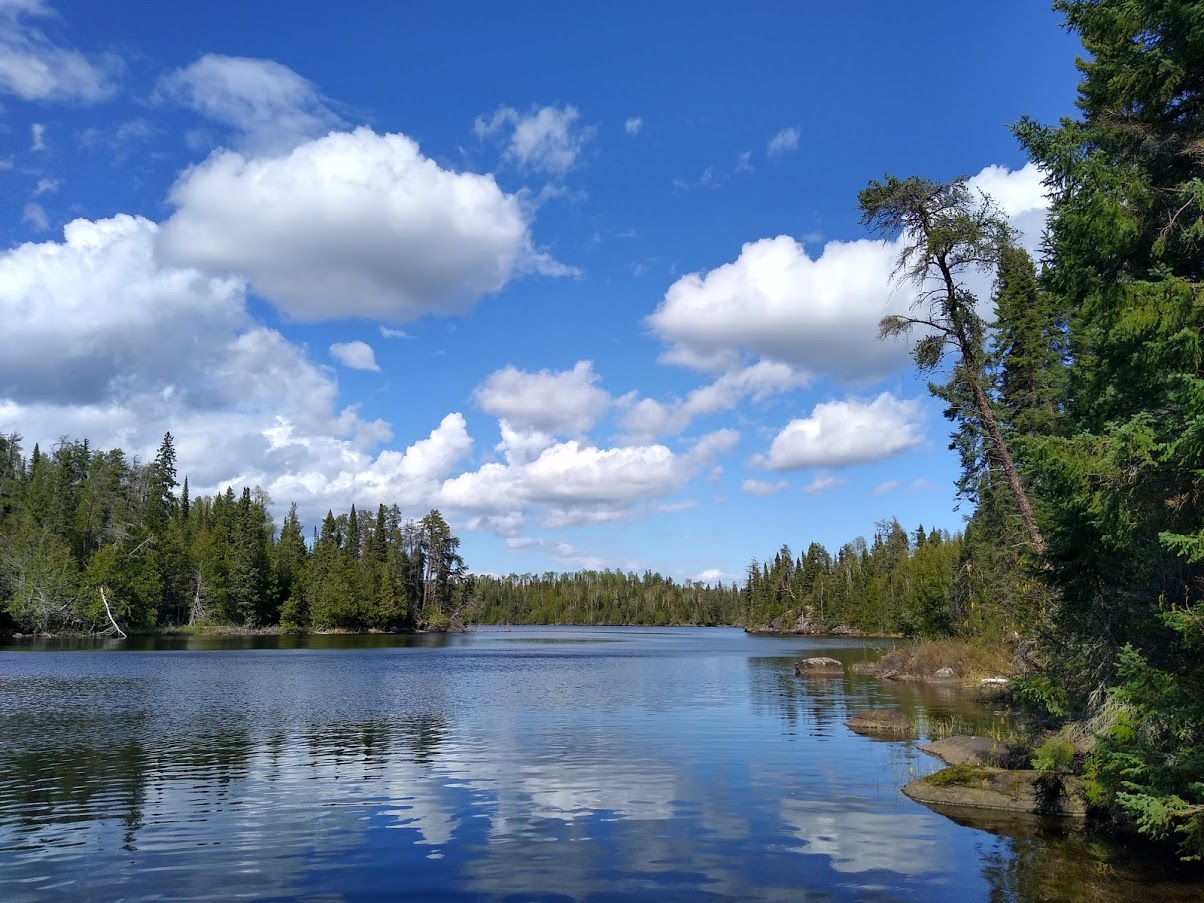
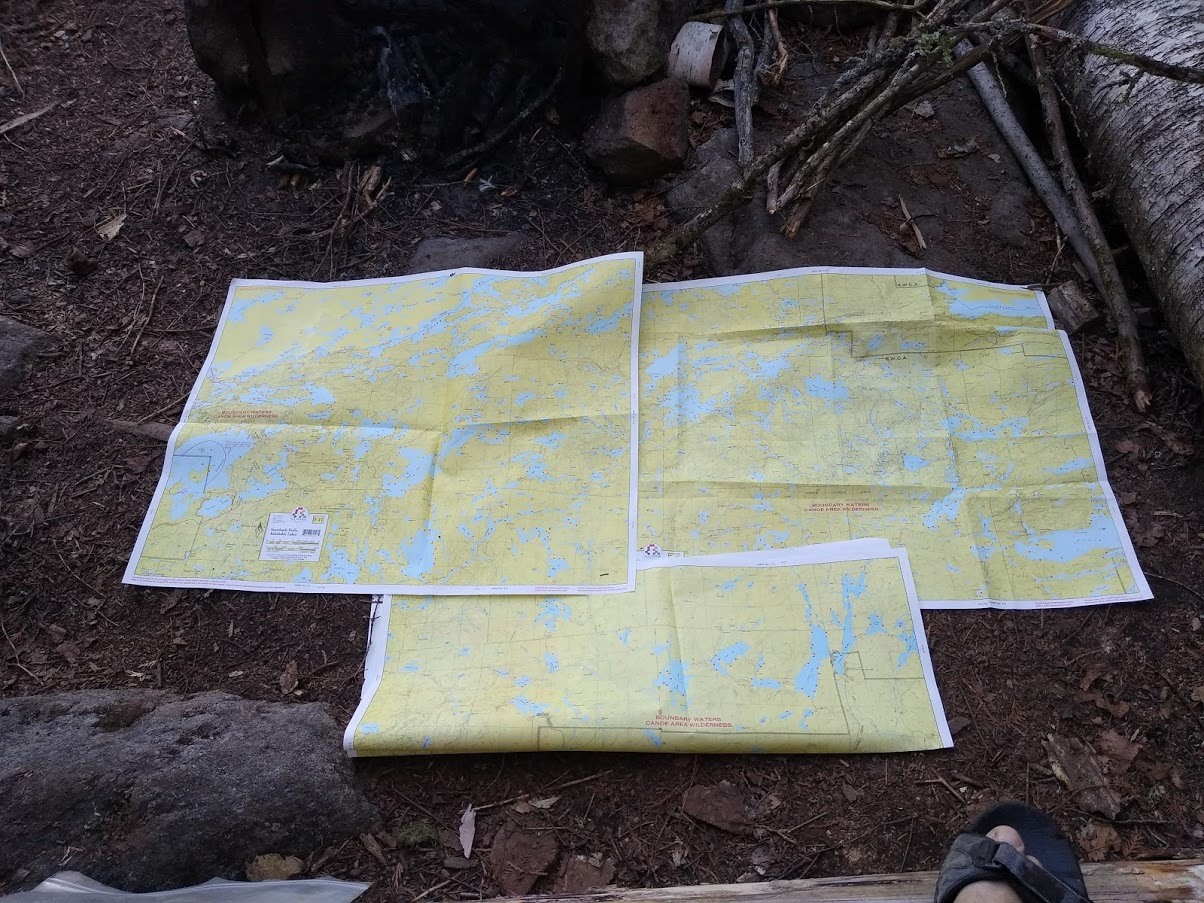

My daily routine appeared to be: wake up, debate a layover day and then decide to move “a little”. Then, several hours later (like 8 or 10), decide that the next open campsite will do just fine and that tomorrow will, almost certainly, be a layover day.
I soon discovered that the camera didn’t survive the previous day. While not hermetically sealed in a dry bag, I had tried to make sure it stayed dry but either I was not diligent enough or it was too flimsy to be suitable for my purposes so I removed the batteries and sealed it in a spare dry bag. I would try it a few more times during the trip but, as I write this, it is on its way to a service center to see if it was water intrusion that killed it or if there is something defective in the camera itself.
After the light rain stopped mid-morning, the day was absolutely beautiful and the only people I saw were a pair that I had seen on the way into Frost lake. They said that they had spent an extra day fishing there and had done pretty well. One of them (or perhaps it was a group from the previous day) lost a naglene bottle on a portage and I picked it up. Before the trip was over, I would eventually add half of a broken ugly stick fishing rod, a couple of rusted lighters and an entire stuff sack full of garbage (that some lazy… let’s say “idiot”...) didn’t feel like carrying to my pack while only losing a lighter of my own in the process.
The bottle was a boon for fish suppers as it solved the problem of how to easily transport the filets. I carried it empty until I caught fish and, once cleaned, the filets were stuffed through the large opening of the bottle and the bottle was filled with fresh lake water. I would change the water periodically if it was a while before camping then simply rinse the bottle after supper.
The Frost river was a slow meandering body of water that was often only as wide as 20-25 feet and wouldn't be deep enough to paddle if not for the proliferation of beaver dams. It was reminiscent of the lazy river at any water based amusement park I’d ever been to except that the scenery was far more beautiful and other people were non-existent.
There were fewer portages than beaver dams on this day and it seemed that the preferred method of navigating a dam was to get up a decent head of steam and plow right over it. Almost all of the dams were fairly small and the drop in elevation was rarely more than a foot or two. I can only remember one place that was high enough to dissuade me from sliding over and, in that case, I stood on the dam and lifted the canoe over instead of portaging around.
While I suspect that the beavers may not view sliding over the dams in the same manner that I do, I can certainly say that it was a fun afternoon to paddle, ram & slide my way down such a gorgeous and pristine area of the forest.
In fact, it was so pretty that I had a hard time selecting photos for this report and I’ll include an extra here if you’ll pardon the interruption of the narrative
I checked out the campsite (#2226 on PP) at Whipped lake on the way past and it appears to be open (has a fire grate and thunderbox… what more could someone want, right?) but the large widow makers that were overhanging every nice tent pad would have me sleeping in the canoe.
Shortly after leaving that campsite I learned that short portages did not always mean easy portages… Honestly, the carry from Afton to Fente, although listed as only 25 rods, was probably the most difficult portage of the trip. It started out going up an extremely steep, 2 part, climb that I would guess to be 50 or 60 feet up (total) and then an even more treacherous descent which, I would think, would be nearly impossible if it were raining and the rocks were slippery. (I read later that it is sometimes possible to line through the rapids but this didn’t occur to me at the time)
I will say that there was a lot of paint on the rocks where people had either dropped canoes or simply slid them down the grade. I, trying to keep as much paint on the canoe as possible, was extremely careful on this portage and still managed to fall on my butt about ½ way down. With the canoe landing on top of me, however, no light blue paint was added to this particular location.
Up. (destination is the opening just above the top right corner of the large rock)
And over. (pictures just do not do this one justice)
The remainder of the day was uneventful but remarkably beautiful. The portage out of Afton, however, had taken a toll and I was thankful for the first open site on Mora. (#527 on PP and a huge site that would be great for a larger group). I hung out a clothesline, rinsed the clothes I was wearing and hung them in hopes that I might have dry clothes in the morning.
I think it was around this point that I scrapped the idea of bailing early on my planned route although I did study the maps closely that night to see if I could minimize the lengths of the portages.
The weather was perfect that night and I couldn’t ask for more. The “I’m OK” message went out at 8:15 and I was out not long afterward.

